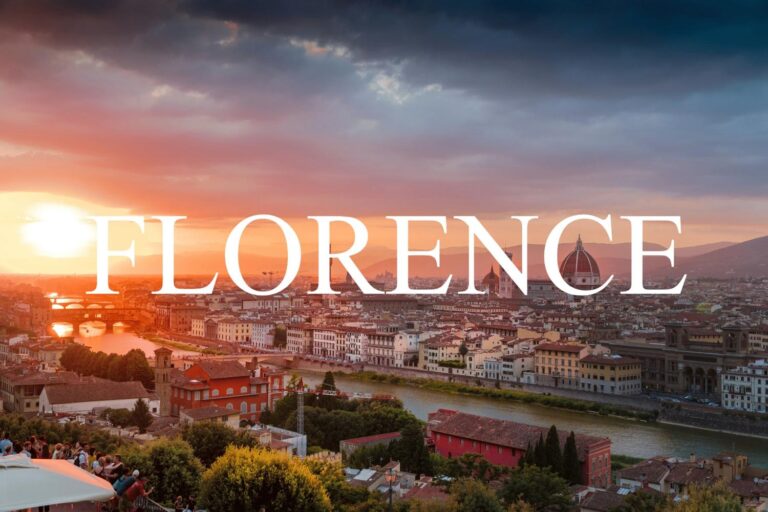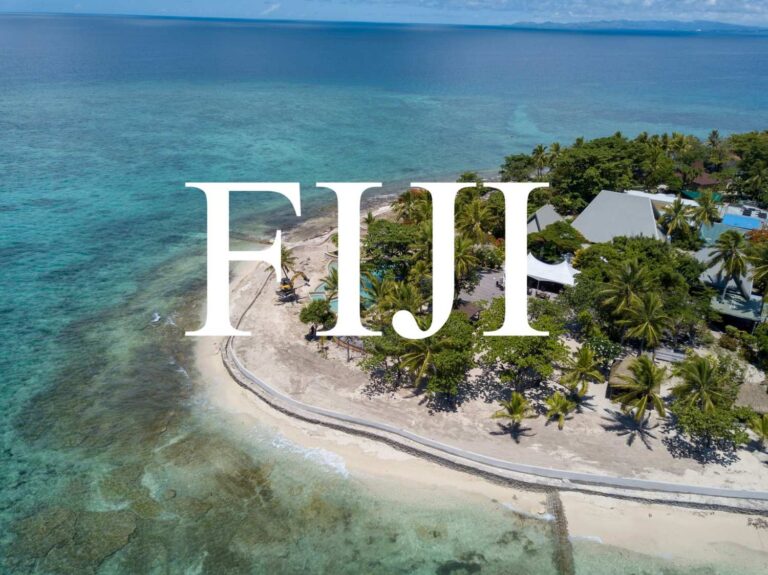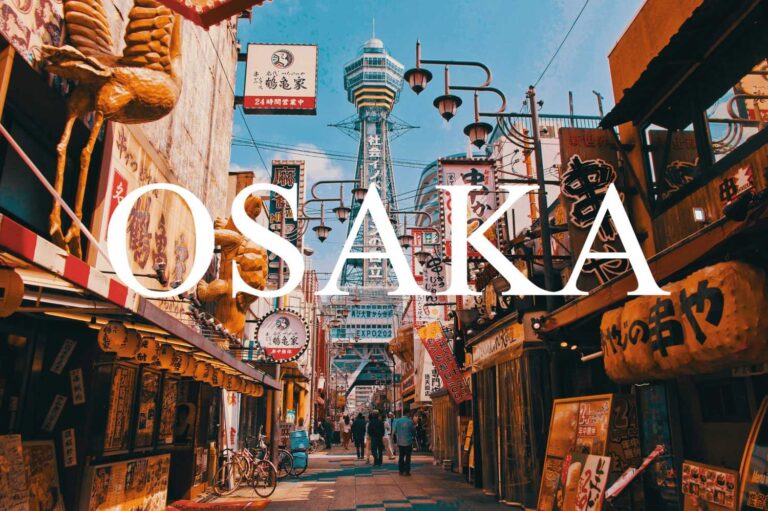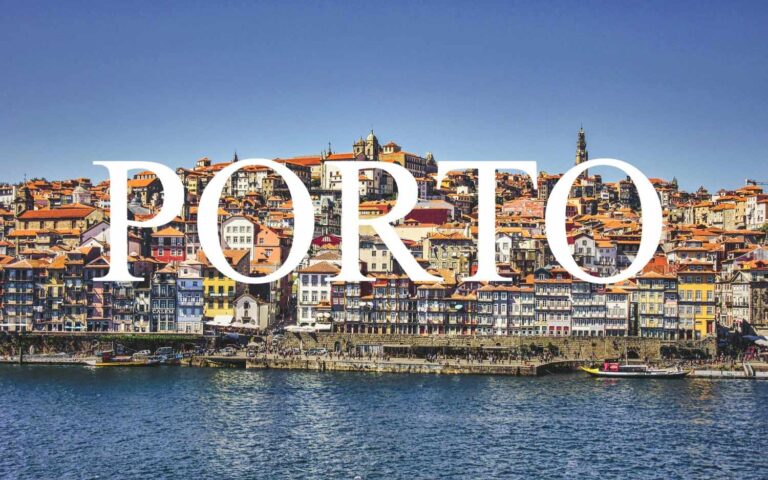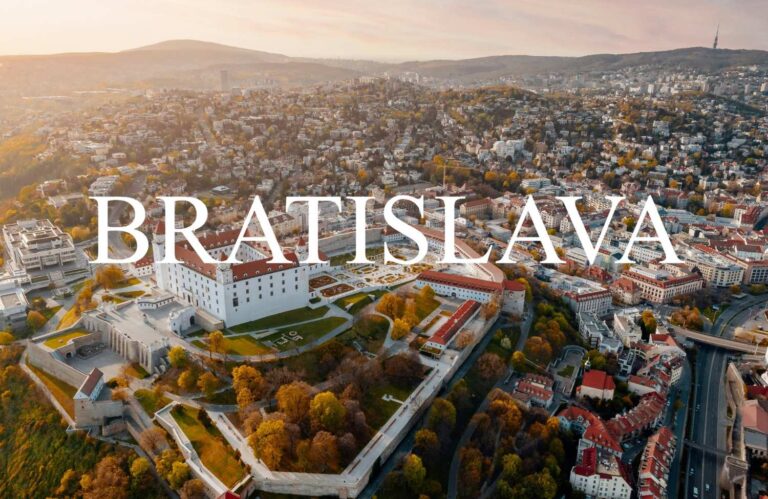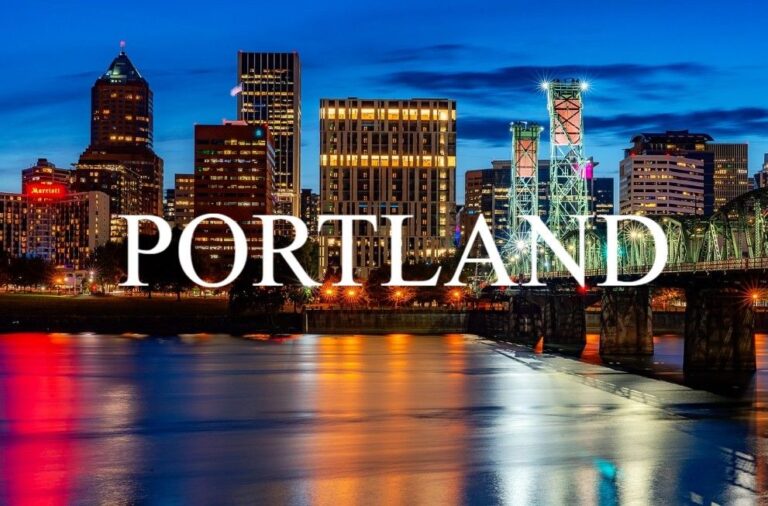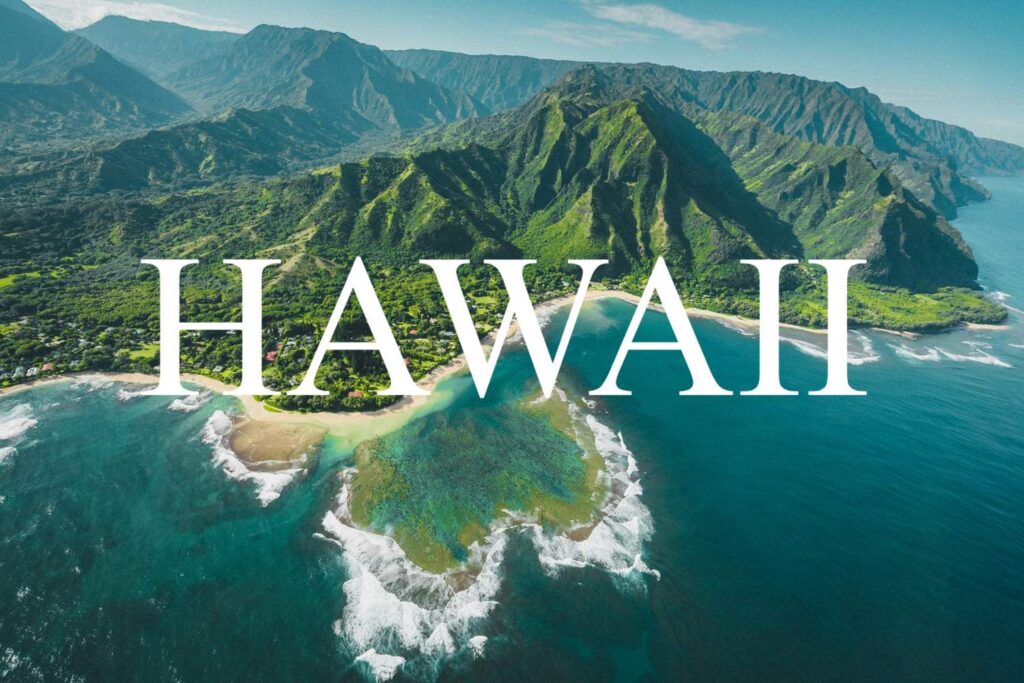
Hawaii, the sun-soaked jewel of the Pacific, is a dreamlike destination where volcanic landscapes, emerald valleys, and pristine beaches come together to create paradise on Earth. Made up of six unique islands—Oahu, Maui, Kauai, Hawaii (Big Island), Lanai, and Molokai—each offers its own flavor of adventure, culture, and natural beauty.
From the moment you step off the plane, the warmth of the aloha spirit welcomes you. Hawaii is more than just a scenic escape—it’s a way of life rooted in respect for nature, connection to the land, and deep cultural traditions passed down through generations.
For beach lovers, Hawaii delivers with turquoise waters, golden sands, and epic surf breaks. Lounge on the iconic shores of Waikiki, snorkel with sea turtles in Molokini Crater, or witness the power of nature at Punaluʻu Black Sand Beach. Adventure seekers can hike to waterfalls on Kauai’s Na Pali Coast, explore lava fields at Hawai’i Volcanoes National Park, or go whale watching off Maui’s coast.
Hawaiian culture is rich and deeply rooted in Polynesian history. Attend a traditional luau, listen to the soulful notes of a live ukulele performance, or learn about hula, the graceful storytelling dance that embodies the islands’ spirit. Visit sacred sites like Puʻuhonua o Hōnaunau or explore local art and history in vibrant towns like Hilo and Lahaina.
The islands are also a feast for the senses. Savor fresh poke bowls, loco moco, shave ice, or sip locally grown Kona coffee while watching the sunrise over the ocean. From high-end resorts to rustic beach bungalows, Hawaii caters to every style of traveler.
Whether you’re seeking heart-pumping adventure, deep cultural connection, or simply a place to unwind surrounded by natural wonders, Hawaii offers an unforgettable experience that stays with you long after the trip ends.
🗓️ Best Time to Visit Hawaii
- 🌴 April to June (Spring): Ideal for pleasant weather, fewer crowds, and vibrant festivals.
- ☀️ September to November (Fall): Warm temperatures, calm seas, and excellent deals on accommodations.
- 🏖️ December to March (Winter): Cooler temperatures with great whale-watching opportunities and big wave surfing on the North Shore.
- 🌿 July to August (Summer): Hot and humid with busy tourist season; perfect for beach lovers.
Hawaii’s tropical climate means it’s great to visit year-round, but spring and fall provide the best balance of weather and crowd levels.
💵 Currency & Travel Essentials
- Currency: United States Dollar (USD, $)
- Language: English (Hawaiian also recognized)
- Transportation: Rental cars are the most convenient way to explore the islands; buses are available in urban areas.
- Average Daily Budget:
- Budget: $80–150
- Mid-range: $150–350
- Luxury: $400+
🏝️ 10 Best Places to Visit in Hawaii
Waikiki Beach (Oahu)

Located on the southern shore of Oahu, Waikiki Beach is one of the most famous beaches in the world, known for its stunning beauty, vibrant atmosphere, and crystal-clear waters. Once a playground for Hawaiian royalty, Waikiki has transformed into a world-class resort destination, offering a perfect mix of relaxation, adventure, and Hawaiian culture. Whether you’re a surfer, sunbather, or shopper, Waikiki Beach is a must-see paradise for any traveler.
🌟 Highlights of Waikiki Beach
• 🏄♂️ Surfing Haven
Waikiki is renowned for its gentle, beginner-friendly waves, making it the perfect spot for learning to surf. Surf schools line the beach, and you’ll often see surfers of all levels riding the waves.
• 🏖️ Sunbathing and Swimming
With its golden sand and calm, shallow waters, Waikiki is ideal for relaxing, swimming, and enjoying the beautiful Hawaiian weather.
• 🌅 Sunset Views
The sunsets at Waikiki are legendary. Watch the sky turn pink and orange over the Pacific, with Diamond Head in the background, creating a picture-perfect moment.
• 🌴 Kapiolani Park
Located just behind Waikiki Beach, Kapiolani Park offers a serene escape with walking paths, gardens, and views of Diamond Head. It’s a great spot for a picnic or a peaceful stroll.
• 🏙️ Vibrant Surroundings
Waikiki Beach is surrounded by luxury resorts, lively restaurants, and high-end shops, making it easy to enjoy world-class dining, shopping, and entertainment right by the beach.
• 💧 Water Sports
Beyond surfing, you can enjoy activities like paddleboarding, snorkeling, and even catamaran cruises that offer incredible views of the coastline and nearby islands.
🚗 How to Get There
• By Public Transport:
Waikiki is well-connected by TheBus, which services the entire island of Oahu. Route 19 and Route 20 both stop in Waikiki, making it easy to reach the beach from Honolulu and other areas.
• By Car:
Waikiki Beach is easily accessible by car, though parking can be scarce. Several parking garages are available, but they tend to fill up quickly, especially during peak times.
• By Bike:
Biking is a popular option in Waikiki, with many bike rental services offering electric bikes and regular bikes for a leisurely ride along the coast.
🕒 Visitor Information
• Best Time to Visit:
The best time to visit is early morning or late afternoon. The beach is less crowded, and the weather is pleasant. The sunsets are stunning, so don’t miss the evening view!
• Opening Hours:
Waikiki Beach is open year-round, 24/7. The area around the beach is always buzzing with life, but the best time to swim or surf is during daylight hours.
• Admission Fee:
Waikiki Beach is free to visit. However, activities like surfing lessons, catamaran rides, or renting beach gear will have additional costs.
💡 Travel Tips
• 🏄♂️ Try Surfing:
Even if you’re a beginner, take a surf lesson. Waikiki is known for its gentle waves, making it the ideal place to try surfing for the first time.
• 🌞 Stay Hydrated:
Hawaii’s sun can be intense. Always have sunscreen, a hat, and plenty of water to stay cool and protected.
• 🚶♀️ Explore the Area:
Waikiki is full of shops, restaurants, and attractions. Take time to walk around and enjoy local spots like the Royal Hawaiian Center or the International Market Place for unique souvenirs.
• 📷 Perfect Photo Opportunities:
Waikiki offers amazing photo opportunities, especially at sunset and in front of Diamond Head. Don’t forget your camera!
Waikiki Beach is a stunning blend of natural beauty and modern convenience, offering something for everyone. Whether you’re into surfing, lounging in the sun, or exploring local culture, Waikiki has it all. Don’t miss this iconic beach when you visit Oahu, as it truly embodies the spirit of Hawaii.
Haleakalā National Park (Maui)
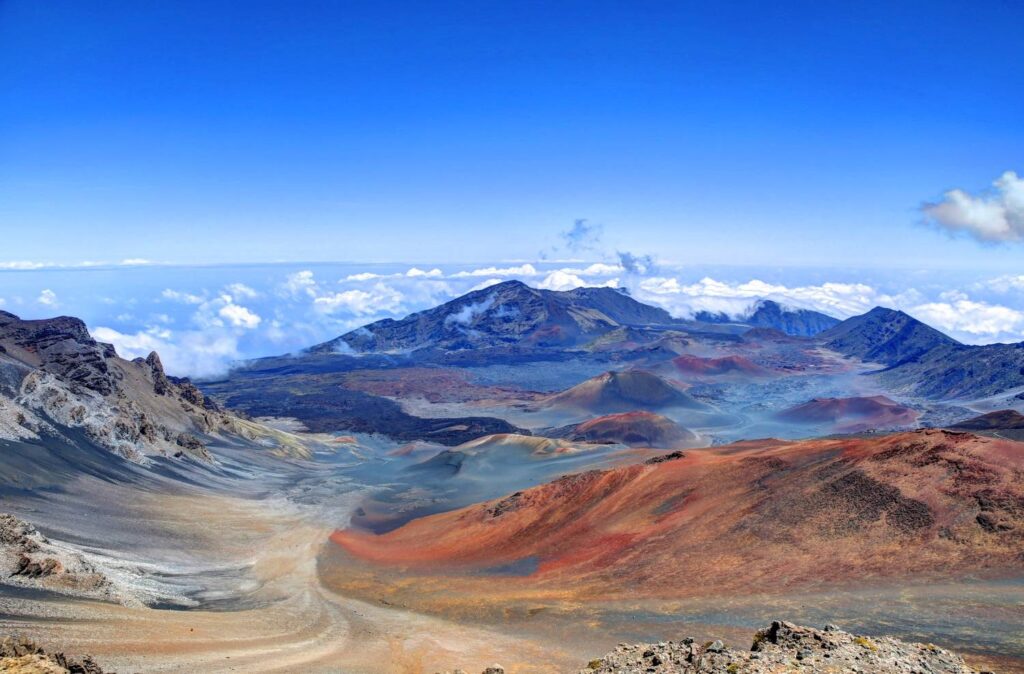
Nestled on the Hawaiian island of Maui, Haleakalā National Park is home to one of the world’s most stunning volcanic landscapes. The park’s centerpiece is Haleakalā Crater, a massive shield volcano that stands at 10,023 feet (3,055 meters) above sea level. Visitors come from around the world to witness its breathtaking sunrise, hike its diverse trails, and explore its rich ecosystems. From lush rainforests to barren volcanic landscapes, Haleakalā offers an unparalleled natural experience, making it a must-see on any Maui itinerary.
🌟 Highlights of Haleakalā National Park
🌅 Sunrise at Haleakalā Crater
• Iconic Sunrise Views
One of the park’s most famous experiences is watching the sunrise from the summit of Haleakalā. The sight of the sun rising over the vast crater, casting hues of red, orange, and pink across the landscape, is a once-in-a-lifetime spectacle.
🏞️ Hiking Trails
• Diverse Landscapes to Explore
The park offers a variety of hiking trails, from easy walks to more challenging treks. Popular trails include the Sliding Sands Trail, which descends into the crater, and the Hosmer Grove Trail, which takes you through a unique montane forest.
🌺 Unique Flora and Fauna
• Endemic Species
Haleakalā is home to a wide range of endemic plants and animals, some of which are found nowhere else on Earth. Visitors can spot rare species like the Hawaiian petrel and silversword plant, a striking species that grows only on the slopes of Haleakalā.
🌲 Scenic Drives and Lookouts
• Drive Through Diverse Ecosystems
The Haleakalā Highway (Route 378) offers visitors stunning views of the park’s various ecosystems as they drive toward the summit. Along the way, you’ll pass through rainforests, barren landscapes, and pastures with panoramic vistas.
🚗 How to Get There
• By Car: Haleakalā National Park is about a 2-hour drive from Kahului or Wailea. The drive to the summit involves a winding, scenic route that requires caution due to its sharp turns and steep elevation.
• By Bus/Guided Tour: There are also guided tours available from various parts of Maui, which offer transportation to the summit and insight into the park’s natural history
🕒 Visitor Information
• Opening Hours: The park is open 24 hours a day, but the summit area is typically accessed early in the morning to catch the sunrise. The Visitor Center at Haleakalā Summit is open from 7:00 AM to 3:00 PM.
• Entrance Fee: The entrance fee for the park is $30 per vehicle (valid for 3 days). A National Parks Pass also provides entry.
• Recommended Visit Duration: Plan to spend 4-6 hours to fully enjoy the summit, hikes, and other park attractions.
💡 Travel Tips
• 🎟️ Sunrise Reservation: If you plan to visit for sunrise, reservations are required (up to 60 days in advance). Be sure to book early to secure your spot.
• 🌞 Dress Warmly: The summit can be quite chilly in the early morning, so bring warm clothing (it can be as cold as 40°F/4°C).
• 🍞 Pack Snacks: While there are facilities at the park entrance, bring your own snacks and water, especially if you plan to hike.
• 👟 Comfortable Shoes: Wear sturdy shoes for hiking, as some trails can be rocky or uneven.
• 🚶 Take It Slow: Due to the high elevation, the air is thinner, and you may feel the effects of altitude. Take your time and stay hydrated.
Haleakalā National Park is a true natural wonder, offering visitors an opportunity to experience Hawaii’s diverse landscapes and ecosystems. From the awe-inspiring sunrise to the volcanic terrain, lush forests, and endemic wildlife, it’s a must-visit destination for nature lovers and adventure seekers. Whether you’re hiking the trails, capturing the sunrise, or simply soaking in the beauty of this remarkable park, Haleakalā promises an unforgettable experience.
Hawai’i Volcanoes National Park (Big Island)
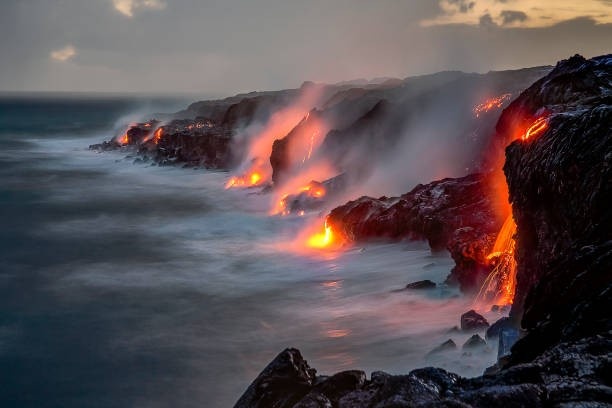
Located on the Big Island of Hawaii, Hawai’i Volcanoes National Park is a breathtaking landscape where the earth’s raw power is on full display. Home to two of the world’s most active volcanoes, Kīlauea and Mauna Loa, this park offers visitors the chance to witness volcanic activity, explore diverse ecosystems, and discover the beauty of Hawaii’s natural wonders. Whether you’re interested in geology, hiking, or just exploring the unique environment, this park is a must-see for nature lovers and adventure seekers.
🌟 Highlights of Hawai’i Volcanoes National Park
• 🌋 Active Volcanoes
The park is famous for its active volcanoes, including Kīlauea, one of the most active volcanoes in the world. You can see lava flows, steam vents, and even lava tubes up close, providing a rare and awe-inspiring experience.
• 🌿 Diverse Ecosystems
Explore a variety of ecosystems, from tropical rainforests to desert-like lava fields. The park’s diverse flora and fauna add to the charm, with opportunities for wildlife sightings, including native birds and plants.
• 🚶♂️ Scenic Hikes
There are numerous trails for all levels, such as the Kīlauea Iki Trail, which takes you through a volcanic crater, and the Sulphur Banks Trail, where you can walk through colorful mineral deposits and steam vents.
• 🌅 Sunrise and Sunset Views
Catch stunning sunrise or sunset views at the Crater Rim Drive or along the Halemaʻumaʻu Crater, where you can witness the sky’s vibrant colors as they contrast against the dramatic volcanic landscape.
• 🗺️ Thurston Lava Tube
Walk through the famous Thurston Lava Tube, a natural tunnel formed by flowing lava, and experience the cool, eerie atmosphere inside.
• 🌋 Jaggar Museum
The Jaggar Museum offers fascinating exhibits on volcanology and the park’s history. You can also get a closer view of Kīlauea’s active caldera from the museum’s observation deck.
• 💡 Nighttime Lava Viewing
Depending on volcanic activity, you can view lava glow at night. Check with the park rangers for current lava flow conditions and the best viewing spots.
🚗 How to Get There
• By Public Transport:
While there is limited public transportation to the park, the best option is to rent a car. The nearest bus station is in Hilo, and you can take a shuttle or taxi to the park entrance.
• By Car:
Hawai’i Volcanoes National Park is about a 45-minute drive from Hilo (approximately 30 miles). If you’re coming from Kailua-Kona, it’s about a 2-hour drive (approximately 96 miles).
• By Bike:
Cycling is a fun way to explore the park’s roads, but note that many areas are best experienced by foot, so biking is recommended for specific trails.
🕒 Visitor Information
• Opening Hours:
The park is open 24 hours a day, but the Visitor Center typically operates from 7:45 AM to 5:00 PM.
• Admission Fee:
- Entrance Fee: $30 per vehicle (valid for 7 days).
- Entrance for pedestrians/bikes: $15.
- Free Days: The park offers free entry on certain National Park Days, so be sure to check the calendar.
• Recommended Duration:
You can spend anywhere from half a day to a full day in the park, depending on how many trails you want to explore and how much time you spend on scenic drives.
💡 Travel Tips
• 🌋 Check Lava Flow Conditions:
Lava flow activity can vary, so check with the National Park Service or the park’s website for updates on current volcanic activity and the best viewing locations.
• 👟 Wear Comfortable Shoes:
The park has uneven terrain and many hiking opportunities, so be sure to wear sturdy, comfortable shoes for walking and exploring.
• 🧴 Stay Hydrated:
Hiking in the park can be physically demanding, especially in the warm Hawaiian sun. Bring plenty of water and sunscreen.
• 🌅 Time Your Visit for Sunset or Sunrise:
To catch the best views, visit early in the morning for a peaceful experience or later in the day to see the sunset glow over the volcanic landscape.
• ⚠️ Be Safe:
Some areas of the park, especially near active volcanic sites, can be dangerous. Always follow the guidelines and advice from park rangers.
Hawai’i Volcanoes National Park is a natural wonder where the raw power of the Earth comes to life. Whether you’re hiking through lush rainforests, exploring volcanic craters, or witnessing the majesty of active lava flows, the park offers an unforgettable experience. For anyone visiting the Big Island, this park is an essential stop to connect with the land’s fiery origins and explore one of the world’s most unique natural landscapes.
Nā Pali Coast (Kauai)
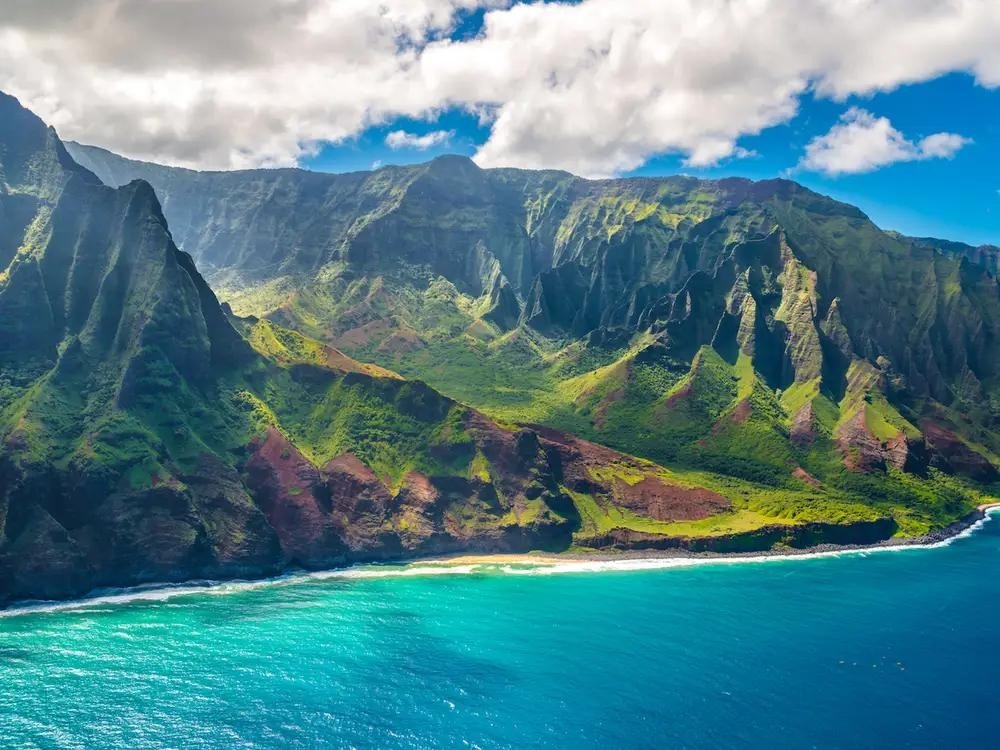
Located on the north shore of Kauai, the Nā Pali Coast is one of Hawaii’s most spectacular natural wonders. Known for its rugged cliffs, lush valleys, cascading waterfalls, and pristine beaches, the Nā Pali Coast is a must-see destination for anyone visiting the Garden Isle. Accessible only by foot, boat, or air, this stunning coastline offers breathtaking views and unforgettable experiences in one of the most remote and unspoiled regions in Hawaii.
🌟 Highlights of Nā Pali Coast
🏞️ Dramatic Cliff Views
• Iconic Scenery
The Nā Pali Coast is famous for its towering, emerald green cliffs that rise 3,000 feet above the Pacific Ocean. These dramatic cliffs are dotted with lush valleys and pristine beaches, creating an awe-inspiring landscape that is perfect for photography and exploration.
🌊 Hiking the Kalalau Trail
• Epic Trail
One of the most famous hikes in Hawaii, the Kalalau Trail takes adventurers through 11 miles of rugged terrain, leading to the stunning Kalalau Beach. Along the way, hikers are treated to jaw-dropping views of the coastline, waterfalls, and valleys. This challenging trail is not for the faint of heart, but the reward is absolutely worth it.
🚤 Boat Tours
• Cruise Along the Coast
For those who prefer not to hike, boat tours along the Nā Pali Coast offer another incredible way to see the cliffs, caves, and waterfalls. Many tours include snorkeling stops and dolphin sightings, making for a complete day of adventure.
✈️ Helicopter Tours
• Aerial Views
Helicopter tours provide an unforgettable aerial perspective of the Nā Pali Coast. Fly above the dramatic cliffs, waterfalls, and valleys to experience the coastline in a way that few people ever will.
🏝️ Hidden Beaches and Waterfalls
• Secluded Beauty
Nā Pali Coast is home to some of Hawaii’s most secluded and pristine beaches, including Kalalau Beach and Hanakapiai Beach. These remote beaches are perfect for a peaceful escape or a picnic in paradise, though they require careful planning and are best accessed by boat or trail.
🚗 How to Get There
• By Car: The Nā Pali Coast is best accessed by boat, hike, or helicopter. The Kalalau Trailhead begins at Ke’e Beach, which is accessible by car. If you’re going on a boat or helicopter tour, there are various operators in Kauai that offer these adventures.
• By Boat: Boat tours are available from Hanalei Bay or Port Allen, depending on your preference.
• By Helicopter: Helicopter tours are available from Lihue or Princeville.
🕒 Visitor Information
• Opening Hours: The Nā Pali Coast is open year-round, but certain areas like the Kalalau Trail require permits. The trail can be very challenging, especially during rainy seasons.
• Entrance Fee: There’s no fee to access the coastline itself, but permits are required for camping on Kalalau Beach (these can be obtained from Hawaii State Parks).
• Recommended Visit Duration: The best way to experience Nā Pali Coast is to spend a full day either hiking, boating, or flying over the area. For those planning to hike, at least 2-3 days for a round-trip hike to Kalalau Beach is ideal.
💡 Travel Tips
• 🎟️ Permits Required: For camping on Kalalau Beach, be sure to secure a permit well in advance as spaces are limited.
• 👟 Proper Footwear: If hiking, bring sturdy hiking boots and plenty of water, as the Kalalau Trail is strenuous and involves navigating steep inclines.
• ☀️ Sun Protection: The weather on the coast can be hot and humid, so pack sunscreen, a hat, and plenty of water.
• 🚤 Check for Weather Conditions: The coast can be affected by high winds and swells, especially during the winter months, so check the weather before booking boat tours or hikes.
The Nā Pali Coast is one of the most beautiful and untouched landscapes in the world. Whether you’re hiking the iconic Kalalau Trail, taking a boat tour to view the towering cliffs, or soaring above it all in a helicopter, this majestic coastline offers unparalleled beauty and adventure. A visit to Nā Pali is an unforgettable experience that showcases the raw power and serenity of nature in its purest form.
Pearl Harbor National Memorial (Oahu)

Located on the island of Oahu, the Pearl Harbor National Memorial stands as a solemn and significant site dedicated to the memory of the events of December 7, 1941, when the Japanese attack on Pearl Harbor led to the United States’ entry into World War II. The memorial honors those who lost their lives that fateful day and preserves the history of one of the most pivotal moments in American history. Visiting this site is a powerful way to reflect on the bravery, sacrifice, and impact of Pearl Harbor on both the nation and the world.
🌟 Highlights of Pearl Harbor National Memorial
• ⛴️ USS Arizona Memorial
The USS Arizona Memorial is the centerpiece of the Pearl Harbor National Memorial. The memorial, floating above the sunken battleship USS Arizona, commemorates the 1,177 crew members who lost their lives during the attack. Visitors can take a boat ride to the memorial and pay respects at the watery grave of the ship.
• ⚓ Pearl Harbor Visitor Center
Start your visit at the Pearl Harbor Visitor Center, where you’ll find engaging exhibits, photographs, and videos that detail the attack and its aftermath. The free introductory film provides a moving and educational overview of the events of December 7, 1941.
• 💥 Battleship Missouri Memorial
The Battleship Missouri, also known as the “Mighty Mo,” is a historic battleship that served in World War II, the Korean War, and the Gulf War. It was here that the Japanese surrender was signed in 1945, marking the end of World War II. Explore the ship’s decks, living quarters, and historic sites on this fascinating tour.
• 🛳️ USS Bowfin Submarine Museum
Visit the USS Bowfin, a submarine known as the “Pearl Harbor Avenger,” which was commissioned just a year after the attack. The museum provides insight into the submarine’s role in World War II, with exhibits showcasing submarine technology and life on board.
• 📜 Pacific Aviation Museum
The Pacific Aviation Museum on Ford Island offers a detailed look at aviation history during the attack on Pearl Harbor. The museum features restored aircraft, including warplanes, and exhibits on aviation technology and military strategy during World War II.
• 🇯🇵 Remembrance and Reflection
The Pearl Harbor Memorial Park is a tranquil place for visitors to reflect on the tragedy and honor the lives lost. The park also features a beautiful garden and plaques dedicated to all those who served during the attack.
🚗 How to Get There
• By Public Transport:
Pearl Harbor is accessible via TheBus, Oahu’s public transportation system. Several routes, including Route 20, stop at the Pearl Harbor Visitor Center, making it easy to reach from downtown Honolulu or Waikiki.
• By Car:
Pearl Harbor is about a 25-minute drive from Waikiki (approximately 12 miles). There is free parking available at the Visitor Center, though spaces can fill up quickly, especially during peak hours. It’s advisable to arrive early to secure a spot.
• By Taxi/Ride-share:
Taxis and ride-share services like Uber and Lyft are also convenient options if you prefer not to drive yourself.
🕒 Visitor Information
• Opening Hours:
The Pearl Harbor Visitor Center is open daily from 7:00 AM to 5:00 PM. The memorials and museums are accessible during these hours, though it’s best to check for special hours or closures before your visit.
• Admission Fees:
- USS Arizona Memorial: Free, but tickets are required for the boat ride to the memorial.
- Battleship Missouri, USS Bowfin, and Pacific Aviation Museum: Separate fees apply, typically around $25–$35 per attraction, with combination tickets available for discounts.
• Recommended Duration:
Plan to spend 3–4 hours exploring the site. This allows time to visit the memorial, explore the museums, and take in the historical context of the events.
💡 Travel Tips
• 🎟️ Get Tickets in Advance:
While the USS Arizona Memorial is free to visit, tickets are required for the boat ride. Reserve tickets in advance to guarantee entry, especially during peak travel seasons.
• 🌞 Arrive Early:
Pearl Harbor is one of Hawaii’s most visited sites, so it’s recommended to arrive early to avoid crowds. The Visitor Center opens at 7:00 AM, and arriving early gives you the best chance to experience the memorials at a quieter time.
• 👟 Comfortable Shoes:
Wear comfortable shoes for walking, as there is quite a bit of walking involved, especially if you plan to visit multiple memorials and museums.
• 🕊️ Respect the Site:
Pearl Harbor is a site of historical and emotional significance. Be mindful of the solemn atmosphere and respectful of those around you.
• 🍽️ Food and Drink:
There are cafes within the Visitor Center offering snacks and beverages. However, food options may be limited, so consider bringing water and light snacks if you plan to stay for a longer visit.
The Pearl Harbor National Memorial is a deeply moving site that provides a rich historical perspective on the attack and its profound impact on the world. From the USS Arizona Memorial to the Battleship Missouri, each part of the memorial offers a chance to reflect, learn, and honor the sacrifices made by the men and women who served during that pivotal moment in history. A visit to Pearl Harbor is not only an educational experience but also a powerful reminder of the importance of peace and the resilience of the human spirit. It is a must-visit site for anyone traveling to Oahu.
Road to Hana (Maui)
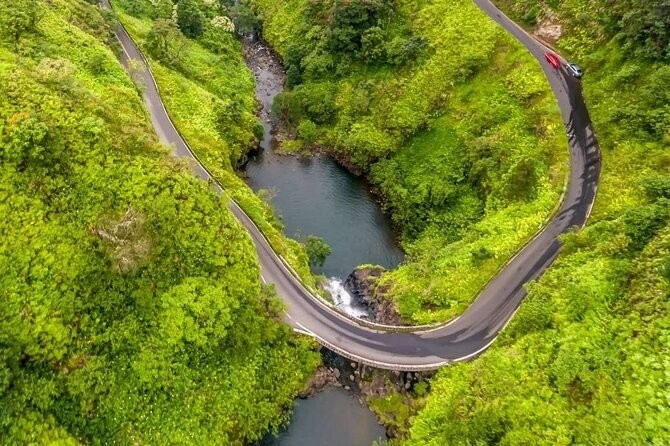
The Road to Hana is one of Maui’s most iconic drives, offering a winding route through lush rainforests, cascading waterfalls, dramatic coastlines, and picturesque beaches. Stretching for about 64 miles along the island’s eastern coast, this scenic highway takes visitors on an unforgettable adventure through one of Hawaii’s most pristine and untouched landscapes. Known for its stunning vistas, hidden gems, and unique Hawaiian attractions, the Road to Hana is a must-experience road trip for any visitor to Maui.
🌟 Highlights of the Road to Hana
🌊 Waterfalls
• Cascading Beauty
The Road to Hana is home to numerous stunning waterfalls, including Twin Falls, Wailua Falls, and Seven Sacred Pools at Oheo Gulch. Stop at various scenic viewpoints to take in the beauty of these natural wonders, and for a truly magical experience, take a refreshing dip in the pools.
🌿 Bamboo Forests
• Magical Hiking Trails
The drive offers access to lush bamboo forests and short hikes, such as the Pipiwai Trail, which takes you through towering bamboo and leads to the stunning Waimoku Falls.
🏖️ Black Sand Beaches
• Unique Coastal Beauty
Along the route, visit the famous Waianapanapa State Park, home to a black sand beach, sea caves, and coastal trails. The striking contrast of black sand against the turquoise water is a photographer’s dream.
🌸 Scenic Viewpoints
• Panoramic Vistas
Several viewpoints along the Road to Hana offer breathtaking vistas of Maui’s coastline, including the Hana Bay and Koki Beach. These spots provide excellent opportunities to pause, soak in the views, and capture stunning photos.
🌺 Traditional Hawaiian Culture
• Cultural Stops
Along the way, you’ll find small roadside stands selling local fruits like banana bread and coconuts. You can also explore the Hana Cultural Center to learn more about the region’s rich heritage.
🚗 How to Get There
• By Car: The Road to Hana begins in Kahului, the island’s main town, and heads towards the small town of Hana on Maui’s east coast. It’s best to rent a car or take a guided tour to experience the drive at your own pace.
• Guided Tours: If you prefer not to drive, guided tours are available that provide in-depth information and stop at key attractions along the way.
• Note: The road is narrow, winding, and often one-lane in some spots, so drive carefully, especially if you’re unfamiliar with mountain roads.
🕒 Visitor Information
• Opening Hours: The Road to Hana is always open, but it’s recommended to start early to fully explore the sights along the route.
• Recommended Visit Duration: The full drive can take about 3 to 4 hours one way, but to truly enjoy the experience, spend an entire day. Many visitors choose to stay overnight in Hana to explore the area more leisurely.
• Entrance Fees: Many stops, like Waianapanapa State Park and Oheo Gulch, may have small entrance fees. Check with the sites ahead of time for updates.
💡 Travel Tips
• 🎥 Plan Your Stops: The drive is long and full of incredible stops, so plan your day with some key attractions in mind, but leave room for spontaneity.
• ⏰ Start Early: Begin your journey early in the morning to avoid the crowds and enjoy the day in peace.
• 🚗 Take Your Time: The Road to Hana is more about the journey than the destination. Don’t rush! Allow for plenty of photo ops and leisurely stops to fully immerse yourself in the beauty of the drive.
• 👟 Wear Comfortable Shoes: Many of the waterfalls and trails require a bit of walking, so comfortable footwear is a must.
• ☔ Check the Weather: Weather can change quickly, especially in the rainforest areas. Bring a light rain jacket, and be prepared for occasional showers.
The Road to Hana offers more than just a drive—it’s an adventure through some of the most stunning natural beauty in the world. From lush jungles and waterfalls to black sand beaches and serene cultural spots, this iconic journey takes you through the heart of Maui’s untouched beauty. Whether you’re hiking to waterfalls, swimming in hidden pools, or simply enjoying the drive, the Road to Hana is an unforgettable Hawaiian experience that should not be missed.
Lanikai Beach (Oahu)
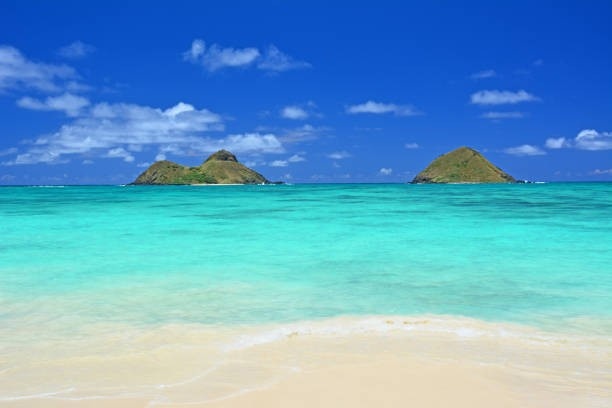
Nestled on the eastern coast of Oahu, Lanikai Beach is often regarded as one of the most beautiful beaches in the world. Known for its powdery white sand, crystal-clear turquoise waters, and breathtaking views, Lanikai Beach offers a peaceful and idyllic escape from the hustle and bustle. Whether you’re looking to relax in the sun, paddle out for a kayak adventure, or simply take in the stunning natural beauty, Lanikai is the perfect spot to unwind and connect with nature.
🌟 Highlights of Lanikai Beach
• 🏝️ Pristine White Sand
Lanikai Beach is famous for its soft, powdery white sand, perfect for lounging or taking long strolls along the shoreline. It’s one of Oahu’s most photogenic beaches, offering postcard-worthy views at every turn.
• 🌊 Calm, Clear Waters
The shallow, calm waters of Lanikai make it ideal for swimming, snorkeling, and wading. The crystal-clear water provides excellent visibility, allowing you to enjoy vibrant marine life just beneath the surface.
• 🛶 Kayaking to the Mokes
One of the standout activities at Lanikai is kayaking to the Na Mokulua (Mokes), two small islands located just offshore. Kayakers can paddle to the islands, where they can explore pristine beaches, enjoy picnics, or simply bask in the beauty of the surrounding scenery.
• 🌅 Stunning Sunrises
Lanikai Beach is one of the best spots on Oahu to witness a stunning sunrise. With unobstructed views of the horizon over the Pacific Ocean, the early morning light creates a mesmerizing atmosphere perfect for photography or peaceful reflection.
• 🏞️ Secluded and Quiet
While Lanikai Beach can be popular among locals and tourists, it retains a sense of peaceful seclusion compared to more tourist-heavy beaches in Oahu. It’s an excellent choice for those seeking tranquility away from the crowds.
• 🐠 Snorkeling Opportunities
The waters around Lanikai are teeming with marine life, making it a fantastic spot for snorkeling. You may spot colorful fish, sea turtles, and even rays as you explore the vibrant coral reefs just off the shore.
🚗 How to Get There
• By Public Transport:
Lanikai Beach is not easily accessible by public transportation, but TheBus provides service to nearby areas. A short taxi or ride-share can take you the final distance from the bus stop to the beach.
• By Car:
Lanikai Beach is a 30-minute drive from Waikiki (about 15 miles). There is limited parking directly at the beach, and spaces can fill up quickly. Visitors often park on nearby residential streets, but be respectful of the local community.
• By Bike:
Cycling to Lanikai Beach is a pleasant and scenic option, especially if you’re staying in Kailua. Bike racks are available at the beach, and it’s a great way to enjoy the area’s beauty at a leisurely pace.
🕒 Visitor Information
• Opening Hours:
Lanikai Beach is open year-round and is accessible at all hours, though it’s best to visit during the day for the safest swimming and best activities. The beach is also ideal for early morning and sunrise visitors.
• Admission Fee:
Lanikai Beach is free to visit and always open, though you may need to pay for parking if you opt for a paid lot.
• Recommended Duration:
To fully enjoy the beach and surrounding activities, plan to spend about 2-4 hours. If you’re planning to kayak or snorkel, you may want to allocate more time.
💡 Travel Tips
• 🌞 Early Morning Visits:
Lanikai Beach is popular for sunrises, so plan an early visit to catch the best view of the morning sky. It’s also quieter before the crowds arrive.
• 🏝️ Respect the Local Community:
Lanikai is a residential area, so be respectful of the local community by parking only in designated areas and keeping noise levels low.
• 🚶♂️ Walk to the Pillbox Hike:
For a stunning view of Lanikai Beach and the Mokes, consider hiking the nearby Lanikai Pillbox Trail. It’s a short but steep hike that rewards you with panoramic views of the beach, coastline, and offshore islands.
• 💦 Bring Snorkeling Gear:
If you’re planning to snorkel, bring your own gear or rent equipment from shops in nearby Kailua. The waters around Lanikai are ideal for spotting marine life.
• 🚰 Hydrate:
While there are no facilities directly on the beach, Kailua town is nearby where you can grab snacks and drinks. Be sure to bring plenty of water, especially on hot days.
Lanikai Beach is a true tropical paradise, offering some of the best natural beauty and peaceful surroundings on Oahu. With its clear waters, soft sand, and access to kayaking adventures, it’s the perfect place to relax, unwind, and connect with nature. Whether you’re looking to swim, snorkel, hike, or simply enjoy a serene beach day, Lanikai Beach is a hidden gem that captures the essence of Hawaii’s charm. Don’t miss the chance to experience one of the world’s most beautiful beaches!
Pololu Valley Lookout (Big Island)
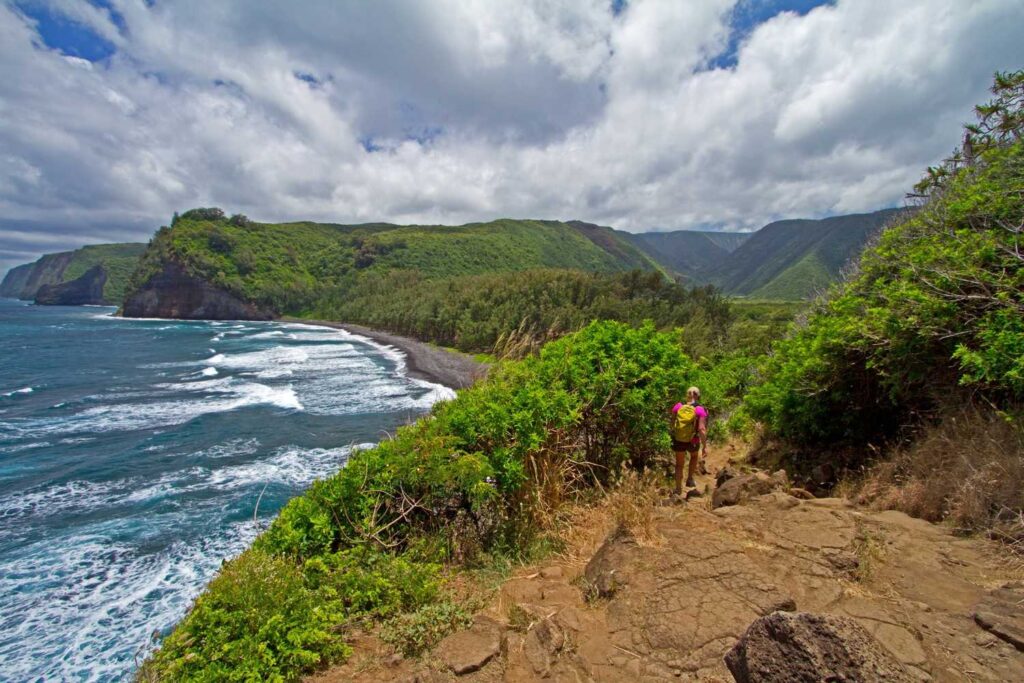
Located at the northern tip of Big Island, the Pololu Valley Lookout offers one of the most breathtaking views in Hawaii. This stunning viewpoint overlooks the Pololu Valley, a lush, verdant valley framed by steep cliffs that descend to a black sand beach below. The combination of dramatic landscape, deep emerald-green valley floors, and the vibrant blue Pacific Ocean makes this a must-visit spot for nature lovers, photographers, and anyone seeking peace in Hawaii’s raw beauty.
🌟 Highlights of Pololu Valley Lookout
🌅 Stunning Views
• Unforgettable Scenery
The Pololu Valley Lookout offers panoramic views of the valley and its lush green hillsides that descend sharply to the ocean. The contrast of the dark cliffs against the sparkling blue waters creates a postcard-perfect scene, making it an ideal spot for photography and reflection.
🏖️ Pololu Valley Beach
• Secluded Black Sand Beach
At the base of the valley, Pololu Beach is accessible by a steep, half-mile trail that offers a rewarding adventure. The black sand beach, surrounded by towering cliffs and jungle-like vegetation, is a peaceful retreat for those willing to make the trek down.
🌳 Rich Vegetation
• Flora and Fauna
The valley is rich with native Hawaiian plants, such as ohia trees, ferns, and the iconic wild ginger. The surrounding cliffs and valleys are a haven for birdwatchers, with species like the honu (sea turtle) sometimes visible along the shore.
🌾 Hiking Opportunities
• Pololu Valley Trail
For the more adventurous, the Pololu Valley Trail takes visitors on a downhill hike through thick forest and eventually down to the beach. Though it’s steep and can be challenging, it offers unparalleled views of the valley and coast. The hike is about 1.5 miles round-trip and is well worth the effort.
🚗 How to Get There
• By Car: The Pololu Valley Lookout is located off Highway 270, about 30 miles from Waimea or Kona. There’s a small parking lot at the lookout point, which can fill up quickly, especially on weekends.
• By Guided Tour: While there are no regular guided tours directly to the lookout, some nature tours of the island may include a visit to Pololu Valley as part of the itinerary.
🕒 Visitor Information
• Opening Hours: The Pololu Valley Lookout is open year-round and accessible at any time. However, it’s best to visit during daylight hours to fully appreciate the views.
• Recommended Visit Duration: Plan to spend 30 minutes to 1 hour at the lookout for pictures and exploring. If you choose to hike down to the beach, allow an additional 1 to 2 hours for the round-trip trail.
💡 Travel Tips
• 👟 Wear Comfortable Shoes: The trail to the valley floor can be steep and slippery in places, so sturdy hiking shoes are recommended.
• 🌞 Early Visit: Arrive early to avoid the crowds and enjoy a peaceful, uninterrupted view of the valley.
• 🕶️ Sun Protection: The lookout can be sunny, so bring sunscreen, a hat, and sunglasses for comfort.
• 🌧️ Be Prepared for Rain: The area around the valley is lush and tropical, so pack light rain gear just in case.
• 📷 Bring Your Camera: The views from the lookout are stunning and a great opportunity for photographs, especially during the golden hours of sunrise and sunset.
Pololu Valley Lookout offers some of the most stunning views on Big Island, with its dramatic cliffs, lush valley, and pristine beaches. Whether you’re simply stopping for a quick photo op or embarking on a scenic hike to the valley floor, it’s an unforgettable spot that showcases the untamed natural beauty of Hawaii. For those seeking peace, solitude, and a connection with nature, Pololu Valley is the perfect destination to explore.
Waimea Canyon (Kauai)

Known as the Grand Canyon of the Pacific, Waimea Canyon on Kauai is one of Hawaii’s most awe-inspiring natural wonders. This dramatic landscape, with its vibrant red and green cliffs, jagged ridges, and lush valleys, stretches over 10 miles long and 3,000 feet deep. Formed by millions of years of volcanic activity and erosion, Waimea Canyon offers visitors jaw-dropping vistas, scenic hikes, and a unique glimpse into Kauai’s geologic history. If you’re an outdoor enthusiast or a lover of breathtaking landscapes, this is a must-visit spot on the island.
🌟 Highlights of Waimea Canyon
• 🌄 Scenic Views
Waimea Canyon offers some of the most stunning views on Kauai. The lookouts along Highway 550 provide panoramic vistas of the canyon’s dramatic cliffs, lush valleys, and the distant ocean. The Waimea Canyon Lookout and Puu Hinahina Lookout are especially popular for capturing the full grandeur of the canyon.
• 🚶♂️ Hiking Trails
For adventure seekers, the canyon is home to a variety of hiking trails that take you through lush forests, past waterfalls, and up close to the canyon’s geological features. The Waimea Canyon Trail and Canyon Trail lead to stunning viewpoints, while the Alaka’i Swamp Trail offers a unique opportunity to explore a high-altitude bog and see native flora and fauna.
• 💧 Waterfalls and Streams
The canyon is home to several waterfalls, including Waipo’o Falls, which cascades 800 feet down the canyon’s cliffs. Streams flow through the valley floor, creating lush, green vegetation in stark contrast to the red earth of the canyon’s walls. These natural features make the area perfect for photography.
• 🌿 Rich Flora and Fauna
The canyon is home to a diverse range of ecosystems, from dry, desert-like conditions to lush, rainforested areas. As you explore the canyon, you’ll encounter native plants and animals, including ferns, hibiscus, and even Nene geese – Hawaii’s state bird.
• 🌅 Sunrise and Sunset Views
For photographers and nature lovers, Waimea Canyon is an incredible spot for sunrise and sunset. The lighting during these times casts a warm, golden glow on the canyon’s cliffs, enhancing its natural beauty.
🚗 How to Get There
• By Car:
Waimea Canyon is located about a 45-minute drive from Kapa’a and 2 hours from Princeville. It is easily accessible by car via Highway 550, which leads directly to the main lookouts and trailheads.
• By Bus:
Public transportation to Waimea Canyon is limited, so renting a car is highly recommended for flexibility. Alternatively, guided tours from major towns like Lihue and Poipu can take you directly to the canyon.
• By Bike:
If you’re up for a challenge, cycling to the canyon is a fun and active way to get there, though it’s a steep climb in parts.
🕒 Visitor Information
• Opening Hours:
Waimea Canyon is open year-round, and you can visit any time of day, but early morning or late afternoon is recommended for the best lighting and cooler temperatures.
• Admission Fee:
There is no entry fee for Waimea Canyon. However, some hiking tours and parking near the lookouts may have small fees.
• Recommended Duration:
Depending on your interests, you can spend anywhere from 2 to 4 hours at Waimea Canyon. If you plan to hike or take a guided tour, allocate more time to fully enjoy the experience.
💡 Travel Tips
• 🚶♂️ Bring Hiking Gear:
If you’re planning to explore the trails, wear sturdy hiking shoes, and bring plenty of water, sunscreen, and a hat. The terrain can be rugged, and some trails can be challenging.
• 🎒 Pack Snacks and Water:
There are limited facilities within the canyon, so it’s a good idea to bring snacks, especially if you plan on hiking or spending a lot of time exploring. Water is essential for staying hydrated, particularly in the hot sun.
• 📸 Early or Late Visits:
To avoid the crowds and catch the best light, try to visit in the early morning or late afternoon. Sunrise and sunset create magical lighting for photography.
• ⚠️ Be Prepared for Weather Changes:
Kauai’s weather can be unpredictable, so bring a light jacket or rain gear, especially if you’re venturing on the trails or into higher elevations.
• 🚗 Parking:
Parking at the main lookouts can get crowded, especially during peak tourist seasons. Arrive early to secure a spot or consider using a guided tour to avoid parking issues.
Waimea Canyon is a must-visit for anyone traveling to Kauai. Whether you’re here for the sweeping vistas, the incredible hiking opportunities, or simply to take in the natural beauty of the island, the canyon offers a little bit of everything. It’s a place where you can connect with nature, marvel at the power of volcanic forces, and enjoy some of the most breathtaking landscapes in Hawaii. A visit to Waimea Canyon is an unforgettable adventure, filled with natural beauty and endless exploration.
Iolani Palace (Oahu)

Located in the heart of Honolulu, Iolani Palace stands as a majestic symbol of Hawaii’s royal history and heritage. Built in 1882, it is the only royal residence in the United States and was once the home of the Hawaiian monarchy. This historical landmark offers visitors a fascinating glimpse into Hawaii’s royal past, showcasing a blend of opulence, tradition, and the island’s cultural heritage. Whether you’re a history enthusiast or simply captivated by beautiful architecture, Iolani Palace is a must-visit on Oahu.
🌟 Highlights of Iolani Palace
🏰 Royal Architecture
• Impressive Design
Iolani Palace features a blend of Victorian and American Florentine architectural styles, with intricate woodwork, elegant staircases, and stunning furnishings. The palace is beautifully preserved, offering visitors an opportunity to step into the world of Hawaiian royalty.
👑 Royal Rooms and Artifacts
• Palace Interiors
Explore the royal chambers, including the throne room, grand hall, and the king’s office, where Queen Liliuokalani and King Kalākaua once ruled. The palace also houses priceless artifacts, including royal regalia and portraits of the Hawaiian monarchy.
🎧 Audio and Guided Tours
• In-Depth Exploration
Take a guided tour or use the audio guide to hear about the history of the palace, the Hawaiian monarchy, and its eventual overthrow in 1893. The tours bring to life the events that unfolded within these walls and provide deep insight into the lives of the royal family.
🌸 The Palace Grounds
• Lush Gardens and Courtyards
The palace grounds are beautifully landscaped, featuring manicured gardens, a palace courtyard, and large statues, including the King Kamehameha I statue that stands proudly in front of the palace. The grounds also host events and ceremonies, keeping the royal legacy alive.
🎶 Cultural Programs
• Special Events
Throughout the year, Iolani Palace hosts cultural events, such as Hawaiian music performances, craft fairs, and special exhibits that celebrate the history of the Hawaiian monarchy.
🚗 How to Get There
• By Car: Iolani Palace is located in downtown Honolulu at 364 S. King Street. It is easily accessible by car, with nearby parking garages and street parking available.
• By Public Transport: The palace is well-served by TheBus, Honolulu’s public transit system, with several routes stopping close to the palace.
• Walking: If you’re staying in downtown Honolulu, the palace is within walking distance from many popular spots like Chinatown, Aloha Tower, and Kaka’ako.
🕒 Visitor Information
• Opening Hours:
Iolani Palace is open for tours Tuesday through Saturday from 9:00 AM to 4:00 PM. It’s closed on Sundays and Mondays, as well as certain holidays.
• Admission Fee:
Admission varies depending on the tour selected. Expect around $20-$27 for a standard admission, and there are discounts for Hawaii residents and children.
• Recommended Visit Duration:
Plan for about 1 to 1.5 hours for a complete tour, though you could easily spend more time exploring the grounds or attending events.
💡 Travel Tips
• 🎟️ Book Tickets in Advance: Iolani Palace can get busy, especially during peak tourist seasons, so booking your tickets in advance is a good idea.
• 👟 Wear Comfortable Shoes: You’ll be walking and standing for a while, so comfortable footwear is recommended.
• 📸 Photography: Photography is allowed in most areas of the palace, but always be mindful of signs that indicate restricted areas.
• 🎧 Audio Guide: If you’re visiting independently, the audio guide is available in multiple languages and is an excellent way to learn more about the palace’s history.
• 🍴 Nearby Dining: After your tour, you can explore nearby eateries like Downtown Honolulu, where you’ll find everything from casual spots to fine dining.
Iolani Palace is an essential stop on any trip to Oahu, offering visitors a unique opportunity to explore Hawaii’s royal past. With its opulent architecture, rich history, and fascinating stories of Hawaii’s monarchy, the palace provides a captivating experience that connects visitors to the island’s cultural and political heritage. Whether you’re a history buff, architecture lover, or simply curious about Hawaii’s past, Iolani Palace is a must-see for anyone visiting Honolulu.
📝 Local Travel Tips
- 🚗 Rent a car: To truly explore Hawaii’s diverse landscapes and hidden gems, renting a car is highly recommended.
- 🌺 Respect local culture: Embrace the “aloha spirit” by being polite and mindful of Hawaiian traditions and natural sites.
- 🏄♂️ Water safety: Always check ocean conditions and heed warnings — currents can be strong even on calm-looking beaches.
- 🍍 Try local foods: Don’t miss poke bowls, loco moco, fresh tropical fruits, and shave ice.
- 📷 Capture responsibly: Respect natural habitats and cultural sites when photographing.
📌 Additional Information
- Safety: Hawaii is generally very safe, but always take standard travel precautions, especially in natural settings.
- Connectivity: Most areas have reliable cell service and Wi-Fi; however, some remote spots may have limited coverage.
- Festivals: Experience the Merrie Monarch Festival (hula), Aloha Festivals, or the Honolulu Festival for authentic cultural immersion.
- Environmental care: Hawaii’s ecosystems are fragile—avoid touching coral reefs and use reef-safe sunscreen.
✨ Final Thoughts
Hawaii is more than a destination — it’s a soul-refreshing escape filled with breathtaking scenery, warm smiles, and timeless traditions. Whether you’re surfing Waikiki’s waves, hiking volcanic trails, or simply soaking in the sunset, the spirit of aloha will make your visit unforgettable.
Pack your swimsuit and your sense of adventure — Hawaii is calling! 🌺🌴🌊

I’m Shreyash Mhashilkar, an IT professional who loves building user-friendly, scalable digital solutions. Outside of coding, I enjoy researching new places, learning about different cultures, and exploring how technology shapes the way we live and travel. I share my experiences and discoveries to help others explore new places, cultures, and ideas with curiosity and enthusiasm.

